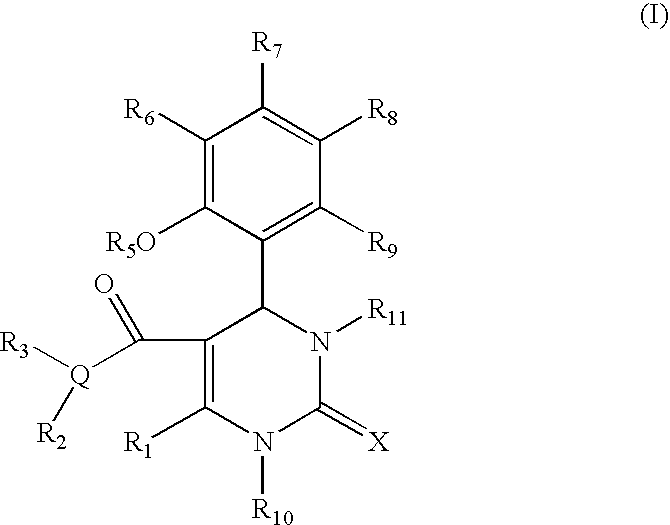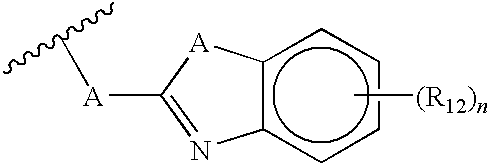Substituted dihydropyrimidines, dihydropyrimidones and dihydropyrimidinethiones as calcium channel blockers
a technology of dihydropyrimidine and dihydropyrimidinethione, which is applied in the field of substituted dihydropyrimidines, dihydropyrimidines and dihydropyrimidinethione compounds, can solve the problems of serious disadvantage in hypertension treatment and the sparseness of compounds inhibiting the t-type channels of these classes of compounds
- Summary
- Abstract
- Description
- Claims
- Application Information
AI Technical Summary
Benefits of technology
Problems solved by technology
Method used
Image
Examples
example 1
Extraction of ene Mixture of Anacardic Acid (2-hydroxy-6-pentadecyl benzoic acid) from Solvent Extracted CNSL
[0158]Commercially available solvent extracted cashew nut shell liquid (CNSL) (100 g) was dissolved in 5% aqueous methanol (600 mL). To the methanolic solution was added activated charcoal (20 g), stirred for 15 minutes, then filtered over celite bed to remove any insoluble material. The clear filtrate was transferred into three neck round bottom flask fitted with a double surface reflux condenser and mechanical stirrer. Calcium hydroxide (50 g) was added in portions at room temperature and the reaction mass temperature was raised to 50° C. and allowed to maintain for 3 hrs. Progress of the reaction was monitored by thin layer chromatography (TLC) using hexane-ethyl acetate (8:2) as mobile phase. After the completion of reaction, the precipitated calcium anacardate was filtered and washed thoroughly with methanol (200 mL). The resultant cake was dried under vacuum at 45-50° C...
example 2
Hydrogenation of Anacardic Acid ene Mixture
[0160]Anacardic acid ene mixture (30 g,) was dissolved in methanol (120 ml). 5% Pd / C (0.75 g, 2.5%) was added slowly and this solution were transferred to 250-mL hydrogenation flask. Initially the solution was flushed with nitrogen and then with hydrogen. Hydrogenation was carried out with 2.5 kg / cm2 hydrogen gas pressure for 2 hrs. Then the solution was filtered through a celite bed to obtain catalyst free solution. This was evaporated under vacuum to get crude saturated anacardic acid. It was then recrystallised from petroleum ether (Yield: 25 g).
example 3
Synthesis of ethyl 2-ethoxy-6-pentadecyl-benzoate
[0161]Anacardic acid (10.11 g, 29 mmol) was dissolved in acetone (60 mL) and potassium carbonate (4.0 g, 29 mmol) was charged. Diethyl sulfate (8.93 g, 58 mmol) was added slowly under stirring. This solution was then transferred to a three-neck flask fitted with a reflux condenser and mechanical stirrer, and refluxed for 4 hrs. Progress of reaction was monitored by TLC (mobile phase: Hexane:EtOAc 9:1). After completion of reaction, it was filtered and acetone was evaporated under vacuum. Crude product was dissolved in dichloromethane (50 mL) and washed with water (2×50 mL), 5% sodium bicarbonate solution (50 mL), saturated brine (50 mL) and finally with distilled water (2×50 mL). The organic layer was dried over anhydrous sodium sulphate, and evaporated under vacuum to give ethyl 2-ethoxy-6-pentadecyl-benzoate as oil. This was then dissolved in minimum amount of petroleum ether (40-60° C.) and cooled to 0° C. to give light brownish cr...
PUM
| Property | Measurement | Unit |
|---|---|---|
| temperature | aaaaa | aaaaa |
| Structure Activity Relations | aaaaa | aaaaa |
| chirality | aaaaa | aaaaa |
Abstract
Description
Claims
Application Information
 Login to View More
Login to View More - R&D
- Intellectual Property
- Life Sciences
- Materials
- Tech Scout
- Unparalleled Data Quality
- Higher Quality Content
- 60% Fewer Hallucinations
Browse by: Latest US Patents, China's latest patents, Technical Efficacy Thesaurus, Application Domain, Technology Topic, Popular Technical Reports.
© 2025 PatSnap. All rights reserved.Legal|Privacy policy|Modern Slavery Act Transparency Statement|Sitemap|About US| Contact US: help@patsnap.com



